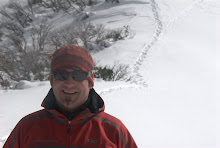
If there's one thing that will ruin your day on the trail, it's the infamous blister!
Blisters are caused by friction, this friction generates heat and this heat initially creates hot spots which if left untreated, pretty soon progress into blisters. The blister itself is a fluid fiulled sack (the fluid is plasma). Blisters occur when things all gets out of whack: your boots could be too stiff so they don't move when your feet move, or your socks ruck up in your boots causing creases which rub. The foot sock and boot should all move as one. Common areas affected by blisters with walkers are the heels (pictured), tops and pads of the toes, and also under the ball of the foot. I would say the heels are the most commonly affected area for walkers.
Seems there as many treatments for blisters as their are hangover cures, so I won't be postulating one all embracing cure-all here; if it works for you, keep on doing it.
Predictably the best treatment is prevention. If you don't get blisters in the first place, you won't need to treat them, so let's have a quick look at what we can do to stop getting blisters in the first place.
- Break your boots in before you go on your walking trip.
I grew up walking in the 70's when walking boots were all made of leather. Out of the box they were as stiff as a board. Try walking in those for five days with a 20kg pack and pretty soon your feet started sporting a nasty assortment of blisters. The trick we learned was to break them in by doing lots of walking in them first: walk around the house, down to the shops, around the park, etc. Softening the boots up was also popular: after walking in your boots the trick was to stuff them full of tissue paper and leave them in a tub of water overnight. Then walk in them again the next day, then repeat. Of course doing the 20 odd river crossings of the Wellington River into Lake Tarli Karng tended to have the same effect! Modern boots aren't all stiff leather (though a boot like the Scarpa SL with a stiff shank certainly needs all this preparation) nevertheless it pays to break all boots in a little. If you don't, you take your chances . . .
- Take care in choosing your socks for walking. Back in the 70's we really only had one choice: the good old Explorer. Now we are spoiled for choice. Make sure your sock is a firm fit and has good quality elastic. You do not want your socks falling down inside your boots. Should you wear two pairs of socks when walking? Old school thinking said yes, with some advocating a thick / thin combo, I used to wear two thick. Now I wear one thick. In my ski boots I wear one pair of long super thin socks (so I can feel the ski through the boot, it's a skier thing). Whatever your choice, make sure you have your boots properly fitted with the socks or sock combination you intend to wear walking.
- Pre-tape. If you have been prone to blisters in the past, then it's a good idea to pre-tape using a compund such as Compeed or Spenco which you use to cover your blister prone areas. Personally I always do this on an extended ski tour as my ski boots are stiff and after all the effort prepping for the trip I don't want my trip cut short by blisters (really I don't want my buddies poaching my fresh trax!) . I rarely pre-tape for walking as I use soft boots and they're always well broken-in so I tend not to get blisters when walking.
- Don't borrow or hire boots. On a walk / ski tour your feet are your most important item. If you get foot problems, chances are that's it, your walk's over. So if there's one bit of kit we should all purchase, it's a good pair of walking boots. Even for skiing if you're going to at all get into the sport, buy your own boots and have your inners specially moulded to your foot. Even the plastic shell moulds to your foot. If you borrow someone else's boots, you're setting your self up for more of these:

I'll leave treatment for another blog, so stay tuned!
Happy Trails!

We should buy shoes on the way we use it, there
ReplyDeleteare special types of shoes are available in the
market for walking or for jogging.
walking boots
Yes that's quite correct. Of course with walking boots they are usually stiff out of the box and the hey is to break them in first before tackling and extended hike.
ReplyDelete